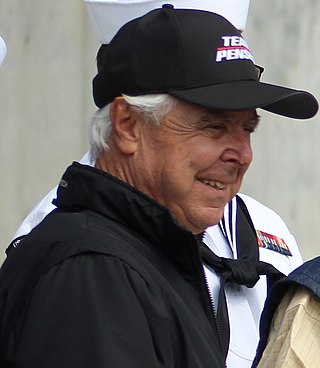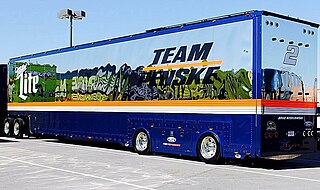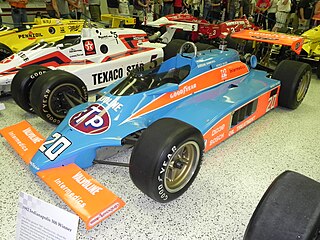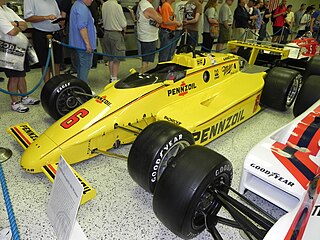
Rick Ravon Mears is a retired American race car driver. He is one of four men to win the Indianapolis 500 four times and is the current record-holder for pole positions in the race with six. Mears is also a three-time Indycar series/World Series champion.

Team Penske is an American professional auto racing organization, competing in the IndyCar Series, NASCAR Cup Series, IMSA SportsCar Championship and FIA World Endurance Championship. Debuting at the 1966 24 Hours of Daytona, the organization has also competed in various other types of professional racing such as Formula One, Can-Am, Trans Am, FIA World Endurance Championship and Australian Supercars. Altogether, Team Penske has earned over 500 victories and over 40 championships in all of auto racing. Team Penske is a division of Penske Corporation, and is owned and chaired by Roger Penske. The team president is Tim Cindric.

Gary Bettenhausen was an American midget car driver. He was the winner the 1967 and 1970 Turkey Night Grand Prix, the 1972 Astro Grand Prix, and the 1976 Hut Hundred.

The 64th 500 Mile International Sweepstakes was held at the Indianapolis Motor Speedway in Speedway, Indiana on Sunday, May 25, 1980. Johnny Rutherford won the pole position, led 118 laps, and won the race by a commanding 29.92 second margin. After failing to finish the race the year before, Jim Hall's radical new Chaparral 2K ground effects chassis was a heavy favorite entering the month, and drove a flawless race. Rutherford, the winner in 1974 and 1976, became the sixth driver to win the Indy 500 three times.

The 66th Indianapolis 500 was held at the Indianapolis Motor Speedway in Speedway, Indiana on Sunday, May 30, 1982. Gordon Johncock, who had previously won the rain-shortened 1973 race, was the winner. Polesitter Rick Mears finished second by a margin of 0.16 seconds, the closest finish in Indy 500 history to that point.

The 76th Indianapolis 500 was held at the Indianapolis Motor Speedway in Speedway, Indiana, on Sunday, May 24, 1992. The race is famous for the fierce battle in the closing laps, as race winner Al Unser Jr. held off second place Scott Goodyear for the victory by 0.043 seconds, the closest finish in Indy history. Unser Jr. became the first second-generation driver to win the Indy 500, following in the footsteps of his father Al Unser Sr. He also became the third member of the famous Unser family to win the race.

The 75th Indianapolis 500 was held at the Indianapolis Motor Speedway in Speedway, Indiana, on Sunday, May 26, 1991. Rick Mears won from the pole position, becoming the third four-time winner of the Indy 500, joining A. J. Foyt and Al Unser. During time trials, Mears also established an Indy record by winning his sixth career pole position. The month of May for Mears was tumultuous, as he suffered his first ever crash at Indy since arriving as a rookie in 1977. The wreck during a practice run totaled his primary car, and broke a bone in his right foot. Mears kept the injury mostly secret, and later admitted that the pain he experienced during the race was so bad, he had to cross his legs in the car and push the accelerator pedal down with his left foot.

The 72nd Indianapolis 500 was held at the Indianapolis Motor Speedway in Speedway, Indiana, on Sunday May 29, 1988. Team Penske dominated the month, sweeping the top three starting positions with Rick Mears winning the pole position, Danny Sullivan at the center of the front row, and Al Unser, Sr. on the outside. Mears set a new track record, becoming the first driver to break the 220 mph barrier in time trials. On race day, the Penske teammates proceeded to lead 192 of the 200 laps, with Rick Mears taking the checkered flag, his third-career Indy 500 victory. The race represented the milestone 50th victory in Championship car racing for owner Roger Penske and Penske Racing.

The 68th Indianapolis 500 was held at the Indianapolis Motor Speedway in Speedway, Indiana on Sunday May 27, 1984. Rick Mears, who previously won in 1979, won his second Indy 500 victories driving for Penske. Contenders Tom Sneva and Mario Andretti dropped out of the race in the second half, leaving Mears alone two laps ahead of the field, and he cruised to the victory. Three months after the race, however, Mears would suffer severe leg injuries in a practice crash at Sanair.

Bill Alsup was an American race car driver. He was the first Championship Auto Racing Teams (CART) Rookie of the Year in 1979 and competed in the 1981 Indianapolis 500, finishing 11th. He made 57 CART & USAC Champ Car starts in his career. His best race finish of third came 3 times and he was the 1981 CART Championship runner-up, putting in a winless but consistent season for Penske Racing, his only effort with a top-level team. He returned to his own team the next year and struggled until leaving Champ Car following the 1984 Sanair Super Speedway race.
The 1979 SCCA/CART Indy Car Series was the inaugural season for the CART Indy car series. It was the first national championship season of American open wheel racing sanctioned by CART. The season consisted of 14 races. Rick Mears was the national champion, and the rookie of the year was Bill Alsup. The 1979 Indianapolis 500 was sanctioned by USAC, but counted towards the CART points championship. Rick Mears won the Indy 500, his first of four victories in the event.

Mark Smith is a former American racing driver who competed in the CART IndyCar Series. Smith won the 1989 United States Formula Super Vee Championship and was the 1991 Indy Lights National Championship runner-up.

The 1980 CART PPG Indy Car World Series season was the second in the CART era of U.S. open-wheel racing. It consisted of twelve races, beginning in Ontario, California on April 13 and concluding in Avondale, Arizona on November 8. The PPG Indy Car World Series Drivers' Champion and Indianapolis 500 winner was Johnny Rutherford. Rookie of the Year was Dennis Firestone. The entire season, including the 64th Indianapolis 500, was to be co-sanctioned by both the USAC and CART under the banner of the Championship Racing League (CRL). However, USAC withdrew from the arrangement after five races.
The 1981 CART PPG Indy Car World Series season, the third in the CART era of U.S. open-wheel racing, consisted of 11 races, beginning in Avondale, Arizona on March 22 and concluding at the same location on October 31. The PPG Indy Car World Series Drivers' Champion was Rick Mears despite missing Round 2 at Milwaukee due to injuries sustained in the Indianapolis 500. Rookie of the Year was Bob Lazier. After the disagreement with the USAC during the previous season, the 65th Indianapolis 500 was not part of the Series, however no competing race was scheduled and most CART teams and drivers did take part.

The Indianapolis Motor Speedway Museum is an automotive museum on the grounds of the Indianapolis Motor Speedway in Speedway, Indiana, United States, which houses the Indianapolis Motor Speedway Hall of Fame. It is intrinsically linked to the Indianapolis 500 and Brickyard 400, but it also includes exhibits reflecting other forms of motorsports, passenger cars, and general automotive history. In 2006, it celebrated its 50th anniversary. The museum foundation possesses several former Indianapolis 500 winning cars, and pace cars, and they are regularly rotated onto the display floor exhibits.
The 1978 USAC Championship Car season consisted of 18 races, beginning at Phoenix on March 18 and concluding at the same location on October 28. The USAC National Champion was Tom Sneva and the Indianapolis 500 winner was Al Unser. This was the last year before the first USAC/CART "Split". By winning the Indianapolis 500, Pocono 500, and California 500, Al Unser swept the Indy car "Triple Crown", the only driver in history to do so.

The Penske PC-23 was a highly successful CART racing car that competed in the 1994 IndyCar season with Penske Racing, and in the 1995 IndyCar season with Bettenhausen Motorsports. It was designed by Nigel Bennett, who based its design on the 1993 car, the PC-22, which was a radical departure from the basic concept of the previous Penske cars. The PC-23 was one of the most dominant open-wheel race cars ever developed. It won both the 1994 CART season, and the 1994 Indianapolis 500 with Al Unser Jr., together with Emerson Fittipaldi and Paul Tracy scoring 12 wins out of 16 in total, collecting 10 pole positions and 28 podium finishes, in a season that saw Penske also take the Constructor's Cup, and the Manufacturer's Cup with the Ilmor-Mercedes-Benz engine. Nevertheless, the car is mostly known for the controversial pushrod Mercedes-Benz 500I engine, designed and developed for the single race of Indianapolis, exploiting a loophole in different technical rules between the Indy 500 and CART sanctioning bodies at that time.

The Penske PC-20 was a CART Penske Racing car which competed in the 1991 and 1992 seasons. In 1991, it raced in all seventeen events, scoring 3 wins, two with Rick Mears, and one with Emerson Fittipaldi, placed 4th and 5th at the season's end respectively. The most remarkable success of the PC-20 was the 1991 Indianapolis 500 win by Mears, his 4th win at the Brickyard. The car was designed by Nigel Bennett, his 4th for Penske Racing. In 1992, it also raced alongside the Penske PC-21.
The following outline is provided as an overview of and topical guide to auto racing:

The Reynard 94I is an open-wheel racing car designed and built by Reynard Racing Cars that competed in the 1994 and 1995 IndyCar seasons, notable for winning the first CART race it entered. The car continued to be raced in the 1996 and 1996-97 Indy Racing League seasons, and holds the unofficial and official lap records at the Indianapolis Motor Speedway.














